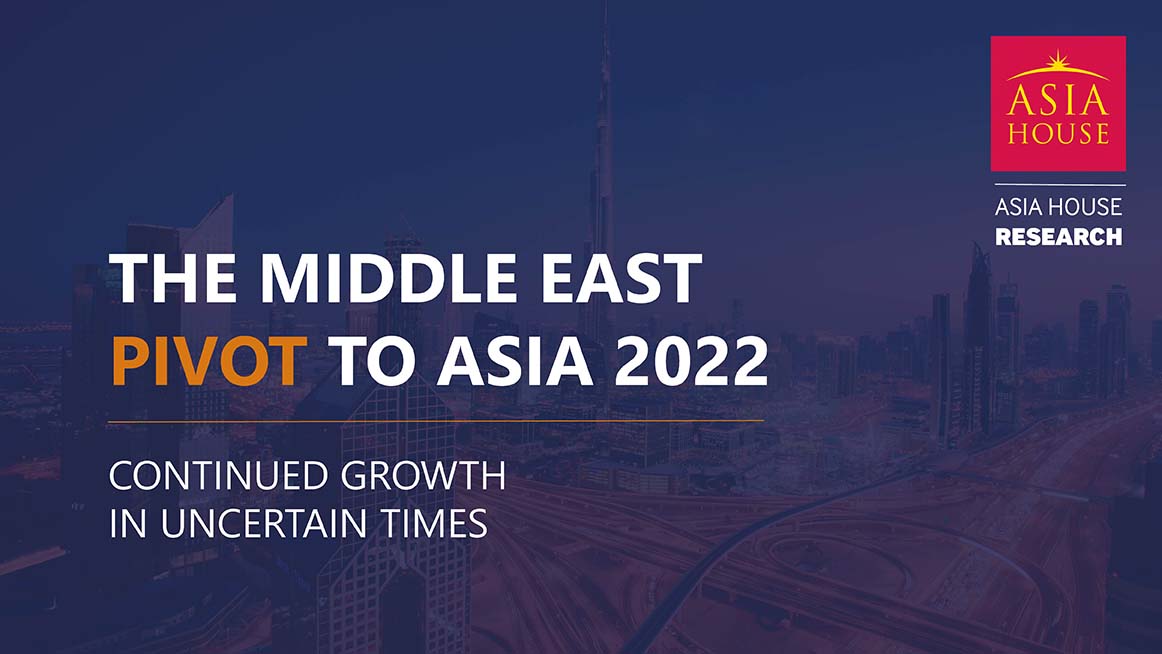Driving commercial and political engagement between Asia, the Middle East and Europe
Driving commercial and political engagement between Asia, the Middle East and Europe
Driving commercial and political engagement between Asia, the Middle East and Europe

Emerging Asia is set to be the Gulf’s biggest trading partner by 2028, according to Asia House’s major research report on Middle East-Asia economic trends.
Trade between the Gulf economies and emerging Asia* surged in 2021 and is expected to reach US$578 billion by 2030, according to new research by Asia House.
Gulf Cooperation Council (GCC) trade with emerging Asia will surpass GCC trade with advanced economies by 2028 if current growth rates are maintained – representing a major shift in global trade dynamics, with Asia on course to be the Gulf’s most important trading partner.
‘The Middle East Pivot to Asia 2022’ report also found that trade between the GCC nations and China is at an all-time high, and in 2021 surpassed the GCC’s trade with the US and Euro Area combined.
The London-based think tank also identified a growth in GCC Sovereign Wealth Fund investments into Asia, driven in part by higher oil revenues, with India and ASEAN nations the major beneficiaries.
However, while energy exports continue to be a key driver of GCC-emerging Asia trade, non-oil trade and investment is also strengthening, with economic and social reforms in the Middle East attracting foreign investment from Asia.
Michael Lawrence, Chief Executive of Asia House, said: “The strengthening of ties between the Gulf and emerging Asia is one of the most significant trends we’re seeing in the world economy. This report shows the scale and pace at which these dynamics are evolving, and highlights new opportunities in both regions across energy, digitalisation and sustainability.
“The economic and geopolitical implications of closer Gulf-Asia links are of critical importance to businesses and policymakers, especially in the face of the bleak global outlook. We trust this report increases understanding of this key trend and its significance in the context of the turbulence in the global economy.”
In addition to the latest analysis by Asia House on the GCC-Asia trade outlook; the key relationships and sectors driving the Pivot; and the opportunities emerging through sustainability initiatives and economic and social reform in the Gulf, ‘The Middle East Pivot to Asia 2022’ also includes insights from business leaders in the region.
The report features interviews with Stephen Moss, Regional Chief Executive Officer – Middle East, North Africa, and Turkey, HSBC; Chermaine Lai, Country Head, Hong Kong, Mashreq Bank; and Waleed Rasromani, Corporate/M&A Partner, Linklaters.
Freddie Neve, Senior Middle East Associate at Asia House and lead author of the report, commented: “We’ve documented a pronounced acceleration in the Gulf’s pivot to Asia over the past year. Gulf-emerging Asia trade has bounced back from COVID-19 faster than expected and there is a strong outlook for further trade growth.
“High oil prices in 2022 will push up the value of trade, but Gulf economic diversification is also expanding non-oil sectors that are benefiting from Asian expertise and investment. We’ve also witnessed an uptick in political engagement between key Asian and Gulf economies, resulting in tangible deals that will drive trade growth, including new Comprehensive Economic Partnership Agreements (CEPAs).”
* ‘Emerging Asia’ refers to the IMF’s ‘Emerging and Developing Asia’ list of 34 Asian economies, which includes China, India, and most ASEAN members, but excludes advanced Asian economies such as Japan, Singapore, South Korea, Hong Kong, Macao, Taiwan, Australia, and New Zealand.
The Middle East Pivot to Asia 2022 report presents Asia House’s latest research on trade and investment trends between the Gulf and emerging Asia.
Produced by the Asia House Research and Advisory team, the report aims to help business leaders and policymakers better understand this pivotal shift in global trade, which will have far-reaching economic and geopolitical implications.
For more information about Asia House’s Middle East expertise and research services, and to enquire about bespoke presentations on the issues covered in the report, please contact Jonathan Smith, Corporate Relations Manager: jonathan.smith@asiahouse.co.uk
